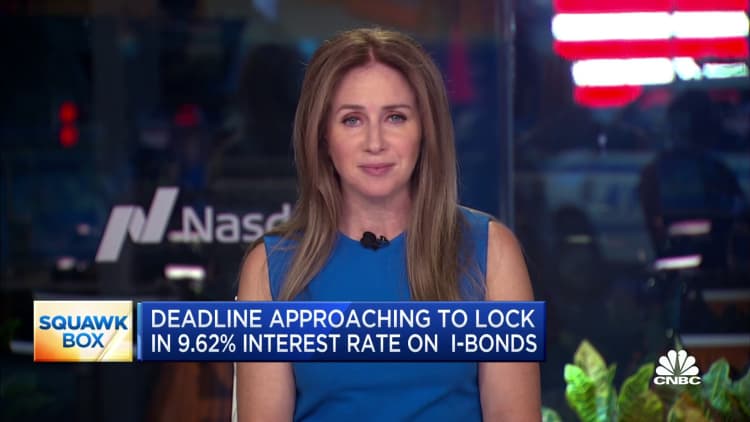
Shapecharge | E+ | Getty Images
Investors crashed the Treasury Department website for Series I bonds on Friday as they clamored to lock in a record-high interest rate before a key deadline.
I bonds have proven to be a bright spot for investors amid declines in the broad stock and bond markets this year. They are a nearly risk-free asset tied to the rate of inflation; as inflation has soared to its highest level in roughly four decades, so too have returns for I bond investors.
Investors must buy I bonds and receive a confirmation email by Oct. 28 to lock in the 9.62% rate, according to TreasuryDirect. The Treasury will announce the new rate next week.
The rate is expected to drop to roughly 6.48%, based on the latest inflation data from the U.S. Bureau of Labor Statistics.
What a TreasuryDirect outage means for investors
An outage on TreasuryDirect.gov — where investors purchase I bonds — may mean they’re unable to complete an I bond purchase by Friday’s deadline to secure the 9.62% rate. The Treasury Department is not planning to extend the deadline, a department spokesperson said Friday.
The website was intermittently available while CNBC reported the story Friday morning. IsItDownRightNow.com, a service that tests web connectivity, listed the TreasuryDirect site as unresponsive during tests between roughly 10:30 am ET and 11:45 am ET.
TreasuryDirect.gov became “one of the most visited websites in the federal government” in the final days of the 9.62% rate window, the Treasury Department said Friday. It typically hosts just a few thousand concurrent visitors.

During periods when the site was accessible, a note on TreasuryDirect read: “We are currently experiencing unprecedented requests for new accounts and purchases of I Bonds. Due to these volumes, we cannot guarantee customers will be able to complete a purchase by the October 28th deadline for the current rate. Our agents are working to help customers who need assistance as quickly as possible.”
A Treasury official confirmed the site “was briefly unavailable” and had “some moments of slow performance.”
“In response, Treasury quickly remediated underlying issues, and more than doubled the connectivity capacity of the site to allow more customers to successfully set up accounts and purchase bonds,” the official said. “We continue to balance these efforts with our commitment to the overall integrity of the 20-year-old system, and protecting the personal identity and financial assets of our customers.”
Demand has created ‘significant pressure and strain’
The Treasury has issued $1.95 billion in I bonds during just the final week of October, according to department figures sent Friday morning. That’s almost double the $1 billion in all of fiscal 2021.
Demand has skyrocketed in recent days. On Thursday alone, users opened 82,000 new TreasuryDirect accounts, and bought $750 million in I bonds. On Friday, by midday, the department said users had opened another 52,000 accounts and generated more than $500 million in sales.
The volume has put “significant pressure and strain on the 20-year-old TreasuryDirect application,” a department spokesperson said Friday.
The site continues to “see customers successfully create accounts and purchase bonds at record levels,” the spokesperson added. “Any additional updates to TreasuryDirect during the final days of the rate window, such as a delay to the November 1 rate change, would pose significant risk to the operational integrity of the system.”
More from Personal Finance:
IRS ‘fully committed’ to better customer service as agency hires 4,000 new workers
Prepare your finances for a recession despite strong GDP report
3 biggest investing mistakes people make during recessions
How I bond interest rates work
I bond rates shift twice a year based on inflation.
There are two parts to the rate: a fixed rate, which stays the same after purchase, and a variable rate, which shifts twice per year based on inflation.
The Department of the Treasury announces new rates every May and November, and you can estimate the next variable rate about two weeks before from the consumer price index reports released in April and October.
The estimates offer a brief period to know roughly what you’ll earn for one year, which is how long you’ll lose access to the funds after buying.
Investors can still lock in the 9.62% annual interest for six months as long as they complete the purchase by Oct. 28. Six months after your purchase date, you’ll earn an estimated 6.48% for another six months.
“It’s nice to know what interest rates you will get when you’re committing to a 12-month lockup,” said Jeremy Keil, a certified financial planner with Keil Financial Partners in Milwaukee.
While it’s too early to estimate rates for May 2023, buying I bonds before the end of October means you’ll receive the May and November rates for six months each.
“That’s an option if someone wants the best of both worlds,” said Ken Tumin, founder and editor of DepositAccounts.com, who tracks I bonds, among other assets.
The downsides of buying I bonds
While roughly knowing I bond rates for one year may be appealing, there are a few things to consider before buying, experts say.
“The biggest downside is you are locked in for 12 months,” Keil said. “You cannot take it out for any reason.” And you’ll give up three months of interest by cashing in before five years.
Still, I bonds may be worth considering for a portion of your emergency savings, as long as there’s other cash readily available for unexpected costs, he said.
And if you’re expecting college tuition bills in 2024, Keil said it’s a “great time” to secure guaranteed interest for one year, which is tax-free for qualified education expenses.
— CNBC’s Kate Dore contributed reporting.
